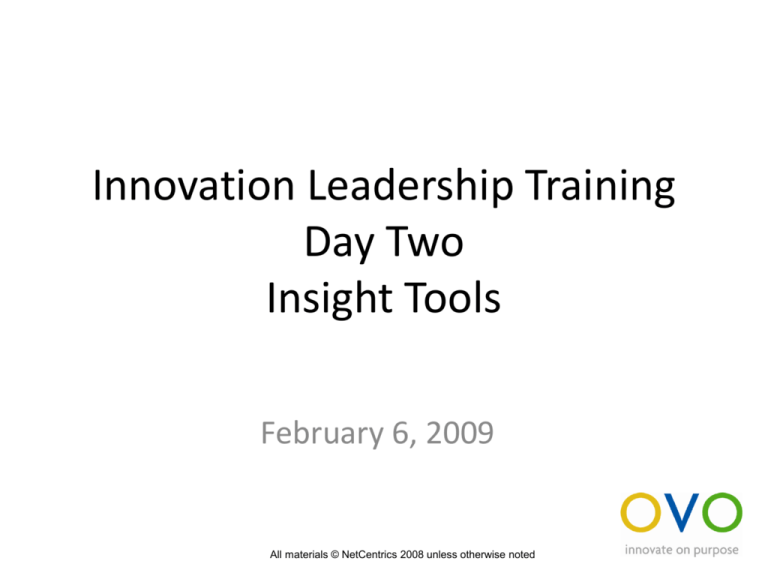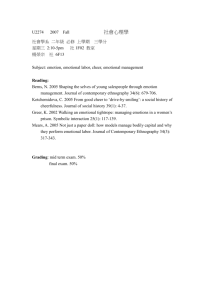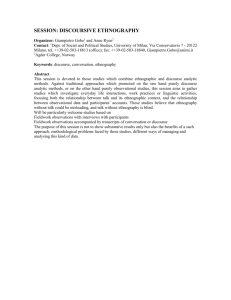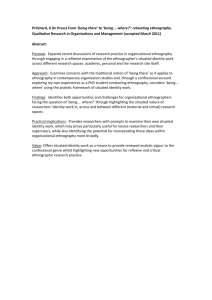Insight Tools
advertisement

Innovation Leadership Training Day Two Insight Tools February 6, 2009 All materials © NetCentrics 2008 unless otherwise noted Welcome • We’ll spend the next hour or so examining several tools and techniques to gather more customer insight What We Want to Accomplish Goals for this section • Our goal this section – Examine several techniques to gain more customer insight • Voice of the Customer • Ethnography • Lead Users – Understand the value proposition of each technique and when to use them Key Points • Market research is an important component of innovation but we need other means to gather customer insights – Market research often imposes our perspective on the questions and therefore the answers • Other helpful tools exist but we need to understand their value proposition and costs – Voice of the Customer, Ethnography and Lead users provide helpful information in certain circumstances Market Research • We all rely on traditional market research to understand what customers want and what they are thinking • There are several significant risks if you rely on standard market research Henry Ford • “If I’d asked my customers what they wanted, they would have said a better horse.” • People have a hard time conceptualizing future products and services and can’t easily respond to traditional market research where new products and services are concerned Other Concerns • Traditional market research is often conducted for a specific outcome or aligned to a specific product or service • There’s a “Hawthorne” effect with traditional market research – the questions we ask, or don’t ask, frame the data we get. • We usually ask existing customers about existing products and services Insight Goals Products/Services Existing New Existing Customers Prospects Methods, tools and techniques change Frequency drops Value increases Three other tools to consider • To obtain insights that are less influenced and more actionable, consider – Voice of the Customer research – Ethnography or “cultural anthropology” – Lead user identification • We’ll consider each of these briefly – Short definition – Why/when useful – Effort/commitment Differences • What makes these approaches different? – More interaction with the prospect or customer – More observation of what they do – More conclusions drawn from observation – Less quantitative, more qualitative – In many cases actions or needs are demonstrated Voice of the Customer • Voice of the Customer research seeks to gain stated and unstated needs from customers through deep interviews – Similar to market research in that it uses prepared questions – Usually much longer in duration, often taped or filmed – From these interviews or discussions need statements are extracted – The need statements are prioritized Why or when useful • The voice of the customer approach helps identify stated needs and by observation or deduction uncovers unstated or unmet needs • Useful when your team can identify likely customers and can actively participate in the interactions to observe what customers say Investment • The investment in a Voice of the Customer study is similar to a standard market research effort, usually with less participants and more involvement from the sponsoring team • A VoC effort usually lasts from 4 to 6 months and requires active involvement of the sponsoring team • Typically a third party facilitator conducts the sessions Ethnography • Also called cultural anthropology, ethnography is an activity that relies less on prepared questions and surveys and more on intense observation • Ethnographers or cultural anthropologists carefully study customers to ascertain their stated and unstated needs, and how they solve problems or address unmet needs • They follow up the observation with specific questions about the activity Why or When useful • Ethnography is useful when you are trying to understand and define unspoken/undiscovered needs and align to existing practices – Keep the Change is a good example • Ethnography is also valuable at identifying nascent trends or activities in customer segments – Trends in fashion and other areas that are just emerging are often discovered by ethnography Investment • Must identify a segment of customers who will agree to be observed in their day to day lives • Ethnography requires an experienced observer to identify key actions • If the first two conditions are met, the timeframe does not have to be long Lead Users • Coined by Eric von Hippl, the author of Democratizing Innovation • Lead Users are people who are creating augmented or improved solutions with existing products or services • Think “mashups” on the web or the classic example of mountain bikes Early Mountain Bikes Why / when useful • Lead users are useful because they are individuals who are creating new solutions to solve unmet needs using your products or those in your market • They are also often on the cusp of new trends Investment • The challenge with “lead users” is not a cost issue but a discovery issue • You will need to find and interact with lead users • Best place to find them is at trade shows, conferences and online on discussion forums • Dell’s IdeaStorm site serves a dual role – to capture ideas and to identify lead users Comparison Approach Value Proposition Issues/Challenges Voice of the Customer Stated and unstated needs Must have experienced VoC observers Ethnography Identifying unmet or undiscovered needs through observation; identification of new trends Identifying a sample of customers who will allow close observation; Experienced ethnographers Lead users Solutions to unmet or undiscovered needs; identification of new trends Identifying the lead users Key Takeaways • Market research is important but only one tool to gather customer insights/feedback • Market research contains some bias and is not always appropriate for unmet/undiscovered needs • Voice of the Customer, Ethnography and Leader user identification can provide increased customer insight • Understand each tool and its appropriate usage Questions Exercise







